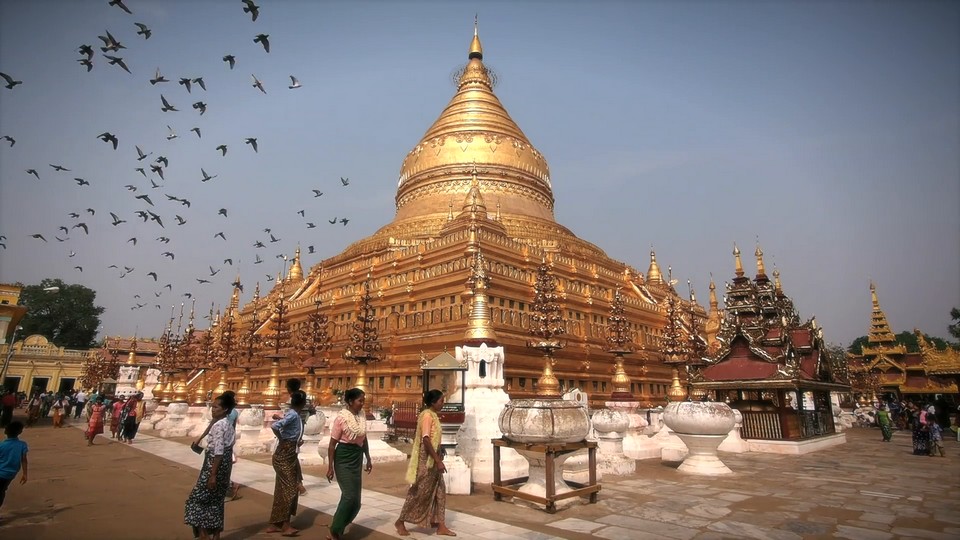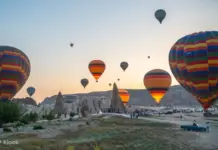Shwezigon Pagoda (Shwezigon Paya, Shwezigon Bagan, Shwezigon Temple, Shwezigon Paya Bagan) is considered the first gold-plated pagoda in Myanmar. It was first built by King Anawrahta in 1059 but was completed by King Kyansittha in 1102. Shwezigon is also the most sacred pagoda in Myanmar.
- Siem Reap tourist attractions — Top 10 best places to visit in Siem Reap, Cambodia
- Banteay Srei Temple — One of the most sacred temple you must visit in Siem Reap, Cambodia
- Visiting Fenghuang Ancient Town — One of the most charming ancient towns of China
- Yangon itinerary 3 days — What to do & how to spend 3 days in Yangon?
- Yangon food guide — 18 famous Yangon foods you should try

Shwedagon Pagoda in Yangon makes visitors admire and praise for building ability, magnificence of thousands of diamonds as well as the entire pagoda decorated with gold. However, little know that Shwedagon Pagoda was not the first gold-plated pagoda in Myanmar. Its shape now is based on the Shwezigon pagoda in Bagan. Shwezigon is just the first gold-plated and the most sacred pagoda in Myanmar.




The history: Shwezigon was built in 1059 under the reign of King Anawrahta – the founder of the Bagan empire, but until the reign of his son King Kyansittha, it was completed in 1102. Over a thousand years, The Shwezigon was damaged by several earthquakes including the 1975 quake but then has been restored and completely gilded again, (according to some documents previously the top is only gold plated). King Anawrahta built the Shwezigon to store the relics of the Buddha.






Unlike many other temples in Bagan, built between the plains, the Shwezigon was built on the sand dunes (the name Shewzigon Paya means “pagoda in the sand dunes”). According to legend, King Anawrahta used a white elephant, carrying the relic on his back, and declared that where the elephant stop, he would build the pagoda, and finally the elephant stopped at the sand dunes and then Shwezigon was built on that.









Shwezigon pagoda is considered a prototype of all future such temples in Myanmar. The pagoda is located on a small sand hill, near the Ayeyawady River, with 4 gates turning in four different directions, with long corridors. At the gates, there are two huge white mammals sitting forward. The pagoda is said to contain the relics of the Buddha’s frontal and collar bones as well as huge Buddha statues. There are dozens of small temples surrounding the main stupa.



The four main stupa s of the Shwezigon pagoda are gilded, with four golden lions at the top of the stupa, a structure like a parasol – found in most temples of Myanmar. Within the compound of the Shwezigon Pagoda are many statues of Buddha from the 12th century and pillars with inscriptions in Mon language that describe the history of Shwezigon Pagoda. According to the tour guide, every year, the exterior of the pagoda is covered with gold plates by Burmese people. Thanks to this layer of gold, the pagoda always glimmers in the sun or at night when dozens of lights or candles are lit up.


Shwezigon is considered a must-visit temple if visitors are in Bagan, along with Ananda, Dhammayangyi, the king’s palace … Today, along the long corridors leading the entrance to the pagoda, local people usually sell souvenirs, including unique sand paintings. The craftsmen dye and use sand to paint the pictures of Bagan. Of course, like many other temples in Myanmar, you are only allowed to go barefoot to visit. (not socks).

Shwezigon Paya Bagan
Address: Nyaung-U, Bagan, Myanmar (Burma)
Opening hours (daylight hours): 05:00 AM – 09:00 PM
Should visit at: 08:00 AM
Should leave before: 10:30 AM
Entrance fee: 5.00 USD
Phone: +95 61 60 262

Are you looking for more top things to do in Bagan: Tours, activities, attractions and other things? Let’s check it out at here.































![10 best airports in Asia in 2016 [RANKED] kuala-lumpur-international-airport-best airports in asia in 2016 by skytrax ratings](https://livingnomads.com/wp-content/uploads/2016/08/29/kuala-lumpur-international-airport-best-airports-in-asia-in-2016-by-skytrax-ratings-218x150.jpg)













































